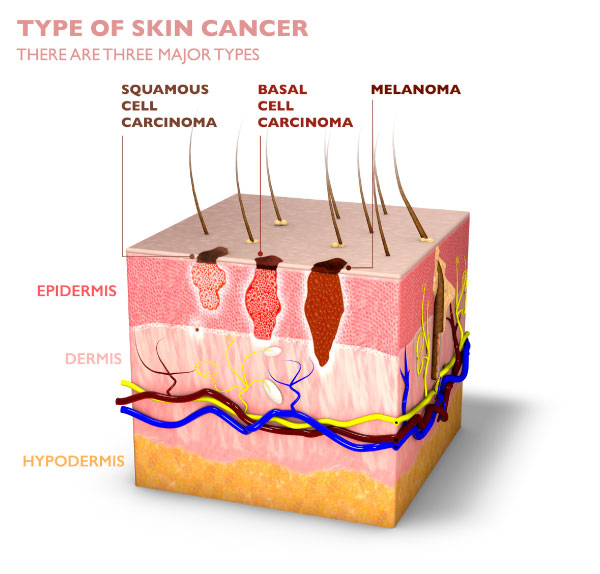How to Spot Skin Cancer Warning Signs
February 23, 2022
In January, a National Hockey League fan saved a life when she noticed an odd-looking mole on the neck of Brian Hamilton, the Vancouver Canuks’ assistant equipment manager. It was no ordinary mole, but potentially deadly malignant melanoma. Thanks to a sharp-eyed med student, he was cancer-free within a week.
Hamilton was lucky, but plenty of people don’t understand or ignore the warning signs of skin cancer.
Unrepaired DNA damage that triggers mutations in cells in the epidermis (the outermost skin layer) causes skin cancers. The mutations cause the epidermal cells to multiply rapidly and form tumors. The majority of skin cancers are treatable if caught early. About 20% of Americans will develop some form of skin cancer – approximately 9500 are diagnosed each day.
Basal Cell Carcinoma
The most common form of skin cancer, basal cell carcinomas are mainly caused by severe UV exposure from sun or tanning beds (think of a sunburn that blisters and peels) and long-term exposure to UV radiation. Untreated, they can cause scars and sometime metastasize, but are rarely fatal.
Warning signs include:
- Rough scaly patches on sun-damaged skin.
- Darkened patches with irregular borders and/or raised lesions that may itch or bleed.
- Open sores that itch or bleed and take a long time to heal.
- Scar-like yellow or waxy areas with irregular borders
Squamous Cell Carcinoma
This is the 2nd most common type of skin cancer. While easy to treat if caught early, these cancers can sometimes grow quickly and metastasize throughout the body. They’re most commonly found on parts of the body that get the most sun exposure and sun damage: face, back, ears, neck, and hands.
Warning signs include:
- Small areas of skin that crust and bleed, but not in response to an acute injury like a fall or cut.
- A wart-like growth that may itch or hurt when touched.
- Rough, scaly patches that may bleed easily.
- A sore that doesn’t heal.
- Raised growths with rough surfaces that may itch or bleed.
Melanoma
This serious type of skin cancer forms in the melanocytes, the cells that give skin its color. Like squamous cell cancer, melanoma is most often caused by intense sun exposure that produces severe sunburn. A melanoma looks like an oddly shaped mole, and can appear anywhere on the body. Melanoma can grow deep into the skin and metastasize throughout the body. It’s treatable if caught early, so be alert to any moles or skin lesions that suddenly change shape or color.
Medical professionals use the “ABCDE rule” to remind people of melanoma’s warning signs
- Asymmetry: The mole has an irregular shape.
- Border: The edges of the mole are jagged, blurred, or uneven.
- Color: The mole may change color over time or be multi-colored, with areas of white, red, gray, or blue.
- Diameter: The mole is large (1/4 inch or greater in diameter) or you’ve noticed growth over time.
- Evolving: You notice changes to an existing mole over time, and the mole may become hard or lumpy. Melanomas that develop in skin lesions may itch or bleed.
Merkel Cell Carcinoma
This rare but aggressive form of skin cancer is most often found on sun-exposed areas of the skin – often on the face, neck, or eyelids. Approximately 80% of Merkel cell cancers are infected with the Merkel cell polyomavirus (a virus that causes cancer). It’s most common in immunosuppressed patients. Cancer can recur even after initial treatment, so early detection is critical.
Warning signs include:
- Painless, small bumps or lesions
- The lesions may be black, blue, or pink.
Skin Cancer Risk Factors
The main risk factor is obvious: sun exposure. Specifically, it’s the ultraviolet (UV) radiation found in sunlight and tanning beds.
According to the CDC, other skin cancer risk factors include:
- Age: Older people get more skin cancers, but the instance of melanomas in younger people (age 20-40) has risen in recent years.
- Skin color: Light-skinned people with freckles and skin that burns easily tend to develop more skin cancers.
- Eye color: Blue or green eyes.
- Hair color: Blonde or red hair
- Family history
- Previous skin cancers
Even if you don’t have many existing risk factors, it’s still important to protect your skin from the sun and see a doctor immediately if you notice any warning signs of skin cancer.
At Bay Alarm Medical, we care about your health and safety. We’re rated as one of the nation’s best medical alert systems, and we can help you create a custom medical alert bundle that meets your budget and lifestyle needs. At home or on the go, Bay Alarm Medical is here for you.



